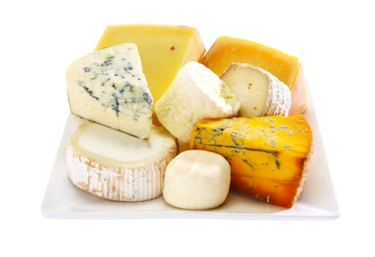Things You'll Need
Stainless steel pot
Cheese cloth
1 gallon of goat or cow milk
Thermometer
2-3 teaspoons buttermilk
1/4 tablet rennet
Strainer
Large bowl
2 teaspoons salt
4-inch by 5-inch tin can with both ends removed
Several handkerchiefs

Making cheese the way it was done centuries ago can be a fun project for home gourmets, and can result in uniquely flavored cheeses. This recipe makes about one pound of cheddar cheese, and once you have mastered this technique you can move on to blue cheeses, soft cheeses and other artisan cheeses. Always make cheese with pasteurized milk, which has been heated to kill any harmful pathogens such as Listeria and E. coli. These can cause serious health problems in children, pregnant women and senior citizens.
Step 1
Sterilize the stainless steel pot and cheesecloth by boiling 1/2 inch of water in the bottom of the pot for five minutes with the cheesecloth in the bottom of the pot. Cover the pot with the lid. Once sterilized, remove the cloth and allow it to dry, and empty the pot of water. Leave the pot on the lid until you are ready to proceed.
Video of the Day
Step 2
Warm the milk to 68 degrees F and stir in the buttermilk. Cover the pot with its lid and let sit at room temperature overnight.
Step 3
Warm the milk to 86 degrees F the next day - be careful not to burn it.
Step 4
Dissolve the 1/4 tablet rennet in 1/4 cup of cold water. Turn off the heat on the milk, and mix the rennet tablet and water into the milk. Cover and leave the milk sitting at room temperature for an hour without disturbing the cheese. Do not stir or remove the lid during this hour.
Step 5
Test the milk to make sure it is ready to proceed after an hour. Stick a clean finger into the top of the milk, and remove. If the milk is gelled solidly enough that it breaks cleanly from your finger as you remove it, proceed to the next step. If not, allow the milk to sit for another hour and repeat this step. Do not stir the milk.
Step 6
Cut the curd with a long knife, making a crosshatch of cuts across the top of the milk curd and reaching all the way to the bottom of the pot. This will result in 1/2 inch cubes of curd on the top of the pot.
Step 7
Place the pot on a low heat and stir with your clean, bare hands. Reach to the bottom of the pot and gently lift the curds to the top to stir. Do not mash over mix the curds, and carefully cut any larger curds that remain in the pot. Stir for 15 minutes to keep the curds from clumping. Heat the curds to 92 degrees F for a soft cheese or 102 degrees F for a firm cheese.
Step 8
Stir and maintain the desired temperature until the mixture resembles scrambled eggs. You will now have chunks of cheese called curds and a clear liquid called whey left in your pot, with the curds sinking below the whey. Pour the curds and whey through a strainer lined with cheesecloth. Place the curds in a large bowl.
Step 9
Sprinkle the salt over the curds and mix with your hands, pouring off any additional whey that accumulates at the top.
Step 10
Line the tin can with a clean handkerchief, and place the warm curds into the can. Cover the curds with the corners of the cloth, and place the top of the can over the corners of cloth. Place the can with the open side facing down into your sink, and weigh down the top with a heavy weight for 12 hours.
Step 11
Remove the cheese from the press and rub the outside of the cheese with salt. Wrap it with a fresh handkerchief, and place the cheese on a rack in your refrigerator.
Step 12
Let the cheese cure for one to two weeks, replacing the handkerchief daily. When the cheese forms a yellowish rind, it is ready to eat or you can dip it in wax and age for over a month to create a sharp cheddar flavor.
Tip
You can save the whey in Step 8 for making ricotta cheese.
Warning
Always use pasteurized milk when making cheese to prevent food poisoning.
Video of the Day